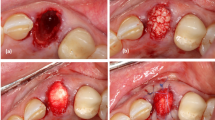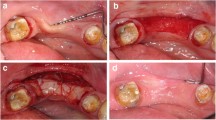Abstract
Objectives
Evidence about the implant protocol and success in the osseous microvascular grafts is not sufficient. Stress distribution around dental implants is one of the important factors determining treatment success. The purpose of this study was to evaluate stress distribution in the bone supporting the implants inserted in the fibula free flap, in patients with large defects in the posterior of the mandible by finite element analysis (FEA).
Materials and Methods
The CBCT was obtained from one patient with fibula free flap in the posterior of the mandible and also from a 4.1 × 10 mm implant (Zimmer, Zimmer dental, Carlsbad, USA). Two 3D finite models were designed containing three or four implants. The implants were splinted by a suprastructure. Vertical load (300 N) and oblique load (50 N) were applied to the suprastructure. The von Mises stress distribution and the micromotion of implants were evaluated.
Results
No significant difference was observed between implants micromotion in two models. According to stress distribution analysis and determining maximum stress regions, the model with four implants imposes more stress on titanium components and surrounding bone.
Conclusion
The stress distribution around the implants of mandibular models with posterior defect that was reconstructed with fibula free flap is better in models with three fixtures versus four fixtures.








Similar content being viewed by others
Availability of Data and Material
Data and material are available.
References
Weischer T, Schettler D, Mohr C (1996) Concept of surgical and implant-supported prostheses in the rehabilitation of patients with oral cancer. Int J Oral Maxillofac Implant 11(6):775–781
Mericske-Stern R, Perren R, Raveh J (1999) Life table analysis and clinical evaluation of oral implants supporting prostheses after resection of malignant tumors. Int J Oral Maxillofac Implants 14(5):673–680
Hayden RE, Mullin DP, Patel AK (2012) Reconstruction of the segmental mandibular defect: current state of the art. Curr Opin Otolaryngol Head Neck Surg 20(4):231–236
Eckardt A, Fokas K (2003) Microsurgical reconstruction in the head and neck region: an 18-year experience with 500 consecutive cases. J Cranio-Maxillofaci Surg 31(4):197–201
Daya M (2008) Peroneal artery perforator chimeric flap: changing the perspective in free fibula flap use in complex oromandibular reconstruction. J Reconstr Microsurg 24(06):413–418
O’Leary MJ, Martin PJ, Hayden RE (1994) The neurocutaneous free fibula flap in mandibular reconstruction. Otolaryngol Clin North Am 27(6):1081–1096
Colletti G, Autelitano L, Rabbiosi D, Biglioli F, Chiapasco M, Mandalà M et al (2014) Technical refinements in mandibular reconstruction with free fibula flaps: outcome-oriented retrospective review of 99 cases. Acta Otorhinolaryngologica Italica 34(5):342
Hidalgo DA (1989) Fibula free flap: a new method of mandible reconstruction. Plast Reconstr Surg 84(1):71–79
Chiapasco M, Biglioli F, Autelitano L, Romeo E, Brusati R (2006) Clinical outcome of dental implants placed in fibula-free flaps used for the reconstruction of maxillo-mandibular defects following ablation for tumors or osteoradionecrosis. Clin Oral Implant Res 17(2):220–228
Rho JY, Ashman RB, Turner CH (1993) Young’s modulus of trabecular and cortical bone material: ultrasonic and microtensile measurements. J Biomech 26(2):111–119
Nagasao T, Kobayashi M, Tsuchiya Y, Kaneko T, Nakajima T (2002) Finite element analysis of the stresses around endosseous implants in various reconstructed mandibular models. J Cranio-Maxillofac Surg 30(3):170–177. https://doi.org/10.1054/jcms.2002.0310
Menicucci G, Mossolov A, Mozzati M, Lorenzetti M, Preti G (2002) Tooth–implant connection: some biomechanical aspects based on finite element analyses. Clin Oral Implant Res 13(3):334–341
Geng J-P, Tan KB, Liu G-R (2001) Application of finite element analysis in implant dentistry: a review of the literature. J Prosthet Dent 85(6):585–598
Papavasiliou G, Kamposiora P, Bayne S, Felton D (1997) 3D-FEA of osseointegration percentages and patterns on implant-bone interfacial stresses. J Dent 25(6):485–491
Ashman R, Van Buskirk W (1987) The elastic properties of a human mandible. Adv Dent Res 1(1):64–67
Klesper B, Wahn J, Koebke J (2000) Comparisons of bone volumes and densities relating to osseointegrated implants in microvascularly reconstructed mandibles: a study of cadaveric radius and fibula bones. J Craniomaxillofac Surg 28(2):110–115
Himmlova L, Dostálová T, Kácovský A, Konvičková S (2004) Influence of implant length and diameter on stress distribution: a finite element analysis. J Prosthet Dent 91(1):20–5
Rubo JH, Capello Souza EA (2008) Finite element analysis of stress in bone adjacent to dental implants. J Oral Implantol 34(5):248–255
Holmes DC, Loftus JT (1997) Influence of bone quality on stress distribution for endosseous implants. J Oral Implantol 23(3):104–111
Ichikawa T, Kanitani H, Wigianto R, Kawamoto N, Matsumoto N (1997) Abstract. Clin Oral Implant Res 8(1):18–22
Simsek B, Erkmen E, Yilmaz D, Eser A (2006) Effects of different inter-implant distances on the stress distribution around endosseous implants in posterior mandible: a 3D finite element analysis. Med Eng Phys 28(3):199–213
Clelland NL, Gilat A, McGlumphy EA, Brantley WA (1993) A photoelastic and strain gauge analysis of angled abutments for an implant system. Int J Oral Maxillofac Implants 8(5):17–31
Rieger M, Fareed K, Adams W, Tanquist R (1989) Bone stress distribution for three endosseous implants. J Prosthet Dent 61(2):223–228
French AA (1989) Comparison of periimplant stresses transmitted by four commercially available osseointegrated implants. Int J Periodont Restorative Dent 9:221–230
Liu B, Li D (2000) Functional construction of mandible after oncologic surgery. Pract Oncol 15:366–370
Ying T, Wang DM, Tong J, Wang CT, Zhang CP (2006) Three-dimensional finite-element analysis investigating the biomechanical effects of human mandibular reconstruction with autogenous bone grafts. J Cranio-Maxillofac Surg 34(5):290–298
Anne-Gaëlle B, Samuel S, Julie B, Renaud L, Pierre B (2011) Dental implant placement after mandibular reconstruction by microvascular free fibula flap: current knowledge and remaining questions. Oral Oncol 47:1099–1110
Eskitascioglu G, Usumez A, Sevimay M, Soykan E, Unsal E (2004) The influence of occlusal loading location on stresses transferred to implant-supported prostheses and supporting bone: a three-dimensional finite element study. J Prosthet Dent 91:144–150
Goker F, Baj A, Bolzoni AR, Maiorana C, Gianni AB, Fabbro MD (2020) Dental implant-based oral rehabilitation in patients reconstructed with free fibula flaps: clinical study with a follow-up 3 to 6 years. Clin Implant Dent Relat Res 22:514–522
Nesappan T, Ariga P (2014) Comparison of stresses around dental implants placed in normal and fibula reconstructed mandibular models using finite element analysis. J Clin Diagn Res JCDR 8(8):ZC45
Kumar VV, Jacob P, Ebenezer S, Kuriakose MA, Kekatpure V, Baliarsing AS et al (2016) Implant supported dental rehabilitation following segmental mandibular reconstruction-quality of life outcomes of a prospective randomized trial. J Cranio-Maxillofac Surg 44(7):800–810
Kumar VV, Ebenezer S, Kämmerer PW, Jacob P, Kuriakose MA, Hedne N et al (2016) Implants in free fibula flap supporting dental rehabilitation–Implant and peri-implant related outcomes of a randomized clinical trial. J Cranio-Maxillofac Surg 44(11):1849–1858
Huang YF, Liu SP, Muo CH, Chang CT (2020) Prosthetic design related to peri-implant bone resorption in microvascular free fibular flap among patients with oral cancer: a retrospective clinical study. J Prosthet Dent 124:395–399
Szmukler-Moncler S, Salama H, Reingewirtz Y, Dubruille J (1998) Timing of loading and effect of micromotion on bone–dental implant interface: review of experimental literature. J Biomed Mater Res 43(2):192–203
Pilliar R, Lee J, Maniatopoulos C (1986) Observations on the effect of movement on bone ingrowth into porous-surfaced implants. Clin Orthop Relat Res 208:108–113
Wu JCH, Chen CS, Yip SW, Hsu ML (2012) Stress distribution and micromotion analyses of immediately loaded implants of varying lengths in the mandible and fibular bone grafts: a three-dimensional finite element analysis. Int J Oral Maxillofac Implants 27:77–84
Acknowledgements
The authors claim to have no financial interests, either directly or indirectly, in the products or information listed in this article.
Funding
None.
Author information
Authors and Affiliations
Contributions
All authors contributed to the study conception and design, material preparation, data collection and analysis. The first draft of the manuscript was written by Mohammadreza Hosseinikordkheili and all authors commented on previous versions of the manuscript. All authors read and approved the final manuscript.
Corresponding author
Ethics declarations
Conflict of interest
None.
Additional information
Publisher's Note
Springer Nature remains neutral with regard to jurisdictional claims in published maps and institutional affiliations.
Rights and permissions
About this article
Cite this article
Latifi, F., Tabrizi, R. & Hosseinikordkheili, M. How does the Number of Implants Affect Stress Distribution in Fibula Graft at the Posterior of the Mandible? A Finite Element Analysis. J. Maxillofac. Oral Surg. 22, 304–312 (2023). https://doi.org/10.1007/s12663-022-01743-0
Received:
Accepted:
Published:
Issue Date:
DOI: https://doi.org/10.1007/s12663-022-01743-0




